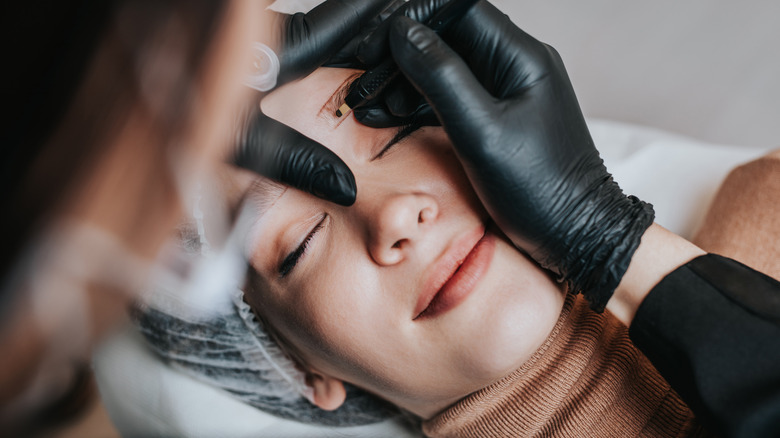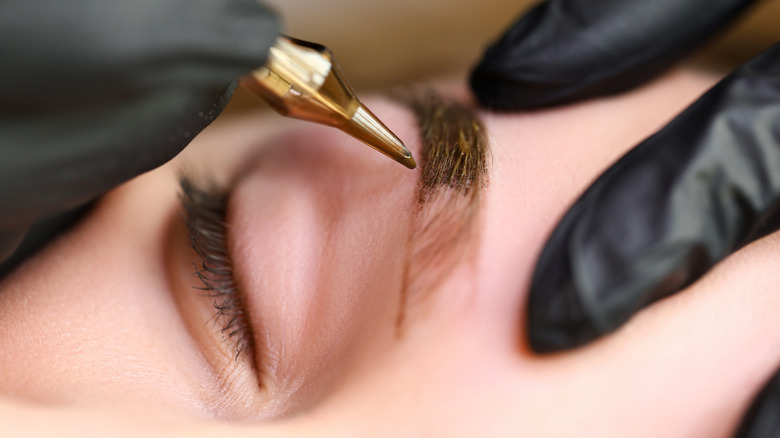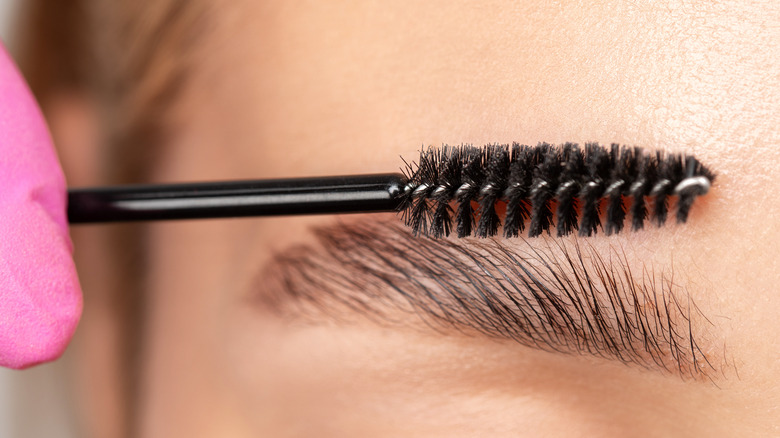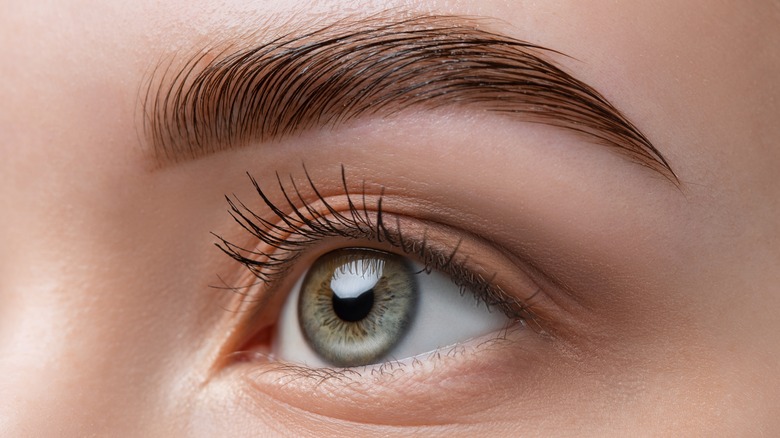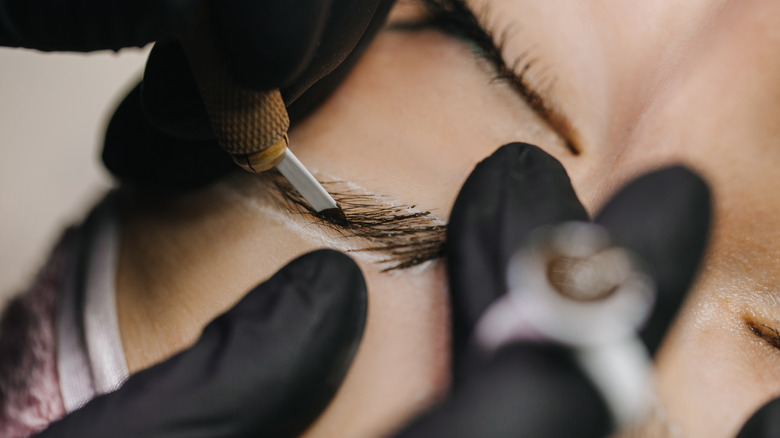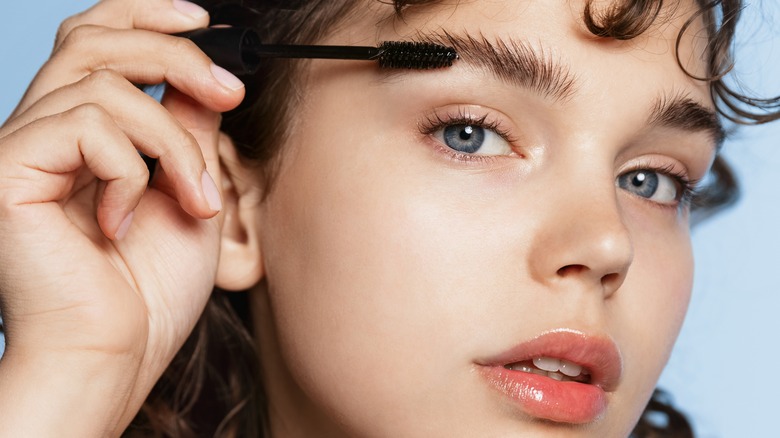Microfeathering Vs Microblading: Points To Consider Before Booking An Appointment
There's always much ado about eyebrows. Ever since the Roaring '20s, eyebrow trends have dominated the beauty space, with a different look cropping up seemingly every decade. It all started with razor-thin eyebrows sported by the first-ever movie stars to make them appear more dramatic on-screen until the likes of Katharine Hepburn and Marilyn Monroe came along and made everyone realize that full is beautiful. Come the '80s, the one and only Brooke Shields popularized the bushy eyebrow look that had people abandoning their tweezers, but a decade later, the pencil-thin silhouette made a resurgence. You probably have to thank Gwen Stefani, among others, for that.
From the 2010s until the present, though, everyone and their mother have been trying to achieve full, natural-looking brows that tread the line between bushy and sculpted. Even though Bella Hadid is at the forefront of the skinny brow renaissance, it looks like the full and feathery trend is here to stay. Unfortunately, not everyone is born with lush, thick brows, and not all can dedicate the time and effort it takes to achieve the look, either.
This is where microblading and microfeathering come into play. These two are semi-permanent eyebrow treatments that deliver the illusion of fullness. While the procedures for both are relatively similar, the final results are noticeably different. So your choice ultimately depends on the look you're going for.
What is microblading?
Microblading is a cosmetic procedure where tiny strokes are tattooed on your eyebrow area, specifically in spots that are sparse or devoid of hair. It's usually recommended for people who barely have brows to begin with, or those with hair growth-related concerns like alopecia. May Lin, a senior microblading specialist, explained to Glamour that, "Microblading is a technique where fine lines are scratched into the surface of the skin, and pigment embedded. The strokes accurately replicate hair (as in a brow or hairline)."
Even though it's technically a tattoo, microblading is still considered semi-permanent since the color fades over time. The pigment used doesn't dig as much into the skin compared to an actual tattoo. The results can completely wane in about two and a half years without touch-ups, but if you want to maintain the look, touch-ups are required once or twice each year.
The results may be well worth it if you're gunning for low-maintenance brows. Sure, you would need to book touch-up appointments every once in a while, but with microblading, you can wake up in the morning with brows that look like the handiwork of Kim Kardashian's makeup artist. It drastically cuts the time you have to spend on your makeup routine, too.
What is microfeathering?
Like microblading, microfeathering is also a semi-permanent cosmetic treatment that involves the depositing of pigment and etching of micro strokes onto the sparse areas of your brows. Its main difference with microblading, however, is that it's developed for people whose brows are already on the fuller side. Microblading typically entails etching natural-looking hair into your whole brow area, while microfeathering is more about filling in the gaps to create a more defined look. The results are noticeably subtler than microblading as well.
"Microfeathering is typically used on areas of the brow that are surrounded with natural hair," celebrity brow artist Kirstie Streicher, who also happens to have trademarked the technique, shared with Allure. "Gaps and sparsely covered areas can be filled in, resulting in the most natural look possible." What's more, international brow expert Samantha Trace told Refinery29 that microfeathering is, "more superficial, which means it's not applied as deep into the skin compared to microblading," meaning it's easier to change its shape or structure later on. Its main goal is to deliver a brow that looks naturally full with clean lines that don't look the least bit tattooed in. On average, microfeathering can last up to a little over a year.
How to choose between microblading and microfeathering
Choosing between microblading and microfeathering ultimately hinges on the brows you already have. If you were not born with full brows, or have patchy brows that require more maintenance than you'd like, then microblading may be your best bet. The technique makes your brows appear fuller and gives them a more defined shape, so you can basically say sayonara to your trusty eyebrow pencil. You can also opt for microblading if you want a complete brow rehaul. "When performed by an expert artist, microblading can be transformative, creating the illusion of great natural brows even if you have none at all," Tracie Giles, founder of Tracie Giles Permanent Makeup & Aesthetic, shared with Refinery29.
On the other hand, if you were blessed with naturally full brows ala Cara Delevingne but want to enhance them by giving them a more full and fluffy appearance, then microfeathering is the treatment for you. The results look completely natural, with the tattooed portions rendered pretty much undetectable. It's the more natural option between the two since your brows won't look too filled in, either. "You should be able to see skin between the hair and the strokes," Kirstie Streicher explained to Byrdie.
What to know before making a commitment
First off, it's worth mentioning that both microfeathering and microblading don't come cheap. Cosmopolitan notes that microblading sessions cost anywhere between $500 to $2,000 depending on where you decide to get them, while microfeathering requires a financial commitment of roughly $2,500. Both options also require at least two sessions, with the first one for defining the shape and filling the brows, and the subsequent appointments for perfecting the look.
As far as pain is concerned, the procedures don't hurt as much as a tattoo does, and a numbing cream or gel is usually applied to your brows before the artist starts to work the needle. Brow artist Alixandria Capparelli likened the pain to a typical brow tweezing session, which you're likely used to already anyway. "On a scale of tweezing your brows to getting a bikini wax, microblading is more like tweezing your brows," she told Cosmoplitan.
Additionally, not everyone is a suitable candidate for microblading and microfeathering. Those with overly oily skin may not be the best candidates. "Oil in the skin can cause the microblading stroke to expand and blur so the less oily the [client's] skin is, the better the result would be," microblading artist Jessica Rowson told Women's Health. Those with very sensitive skin are also advised against doing the treatments since, "this skin type bleeds very easily and has a harder time healing, which causes the pigment to appear more ashy, blurred, and patchy," Kristie Streicher told Byrdie.
Aftercare tips
In between touch-ups for microblading and microfeathering, you don't really need to do much, but that doesn't mean that there's no aftercare required. To help prevent your results from fading fast than they should, Harper's Bazaar recommends limiting your brow's exposure to the sun, and if it can't be helped, you must be diligent in using sunscreen.
You should also be wary about exfoliating when you have microbladed or microfeathered brows. If products like retinol or exfoliating acids touch the area, the pigment on your brows may fade faster. "Glycolic acid, microdermabrasion, and chemical face peel products should be kept away from the tattooed area even after they are healed as continued use could lighten the pigment," restorative tattoo artist Shaughnessy Otsuji, told Allure.
Since you're technically getting tattooed, it's also of utmost importance that you exercise patience during the healing process, which can take up to a month to heal, depending on your skin. You should also make it a point to keep the area clean and dry at all times, and only use products recommended by the technician if you want to accelerate healing.
